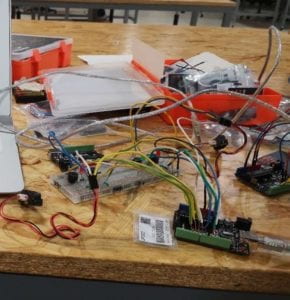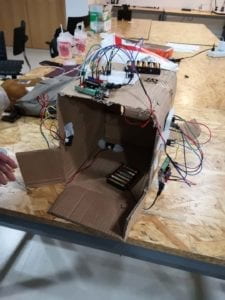My initial understanding of interaction is largely in line with “a cyclic process involving at least 2 actors in possible forms of senses” as illustrated in the previously assigned reading, and I rethought my understanding of interaction based on the previous group project as well as the recitation session for drawing machine. Notably, I would like to add that the actors are not restricted to be humans, interaction could be a mean involving human and machine, allowing individuals to entertain and interact with itself.
My partner Skyler and I started with the rough idea of making an interactive machine that makes sounds based on movements from the user it tracked. It may not necessarily involve a second person, giving room and platform for the user to interact with him/herself through the use of the machine. In addition, instead of making it a strict prototype for a musical instrument, we wanted it to be less strict with movement and sound translation, but rather offer the room of individual exploration. In this sense, people with less background in music training would be able to make music as easy as people with those. It would be more accessible for all walks of life while enjoying the joy of music making. We wanted our project to be as accessible while being attractive.

However, the process of making was not as easy as we expected. In order to track movements and make sounds, we selected distance sensors and regular buzzers. We started with one Arduino, two sharp infrared distance sensors and two buzzers attached to it. The buzzers were coded with the ¾ beats of notes in reference to the theme song of Netflix series Daredevil. Moving forward, we added more sets of buzzers and sensors to the model. However, user testing made me rethink the concept of the project. During the user testing, we have all the circuits attached in a cardboard box with wires left outside. From several users, we learned that the outlook and the sounds it makes does not really give a sense of comfort to the user, and it makes the user less attempting to use it. In the meantime, the purpose of it was not as clear that users did not fully understand what’s going on. To answer these, I asked myself if the user is not clear with where his/her inputs into the interaction will translate back to him/her, would the loop of interaction still happen? The answer is no. So, we went back and tear down the cardboard box, and attached all the sensors in one more apparent way, and in a sense, we believe the change made the user clearer with the purpose and how his inputs may translate into the output by the machine.

The final product, although didn’t work as well as we expected. However, I am generally satisfied with the trajectory of our conceptualization. Our final product, Music Conductor Stimulator, intends to give the user an opportunity to play a sequence of sounds without touching the machine while not being embarrassed to compose since the notes coded already came in melody and all of them are extracted from the same song. Digging into the concept behind it, I think this trajectory allows us to rethink the relationship between dance moves and music: we tend to think that people make dance moves when hearing the music, but would it be interesting if sounds could be the reflection of set of movements, which may already contain some elements of emotions in it. One of the projects I have looked into is called Bounden, which is a mobile interactive game that allows two persons dance with the instructions while the dance music would follow the pace of the completion of the dance moves. It would be fascinating to see relevant interactive projects giving more rooms for human movements and more flexible sounds made out of it. It would be interesting to rethink our project if we look at a similar instrument, theremin demo, it is fascinating to consider building our project into a multi-dimensional platform, in which each dimension would be able to control different spheres of a sequences of sounds: the speed of the music, the pitch of the music, and order of 3/4 beats.
Building upon this trajectory, I am thinking about a room with sensors from all four dimensions and all players are attached and stored with different sets of sounds in several different genres. The ultimate model would be room with that dancer makes dance moves and the sound will react to it based on its sensing of the dance moves.
Reference